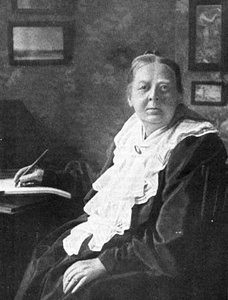Mary Everest Boole facts for kids
Mary Everest Boole (born March 11, 1832, died May 17, 1916) was a clever mathematician who taught herself. She is famous for writing books about math that helped people learn, like Philosophy and Fun of Algebra. She was also married to another mathematician, George Boole. Mary had new ideas about teaching. She believed children should learn math by playing games, like making designs with string (called curve stitching). Her life shows how women could become successful in academics even when it was hard for them.
Contents
Mary Everest Boole's Life
Mary was born in England. Her father was Reverend Thomas Roupell Everest. Her uncle was George Everest, who helped map mountains, and Mount Everest is named after him! Mary lived in France for a while and had a private teacher for math. When she was 11, she moved back to England. She kept learning math on her own.
Early Life and Family
Later, George Boole, who also taught himself math, became her tutor. She visited him in Ireland, where he was a math professor. After her father passed away in 1855, Mary and George got married. She moved to Cork, Ireland. Mary helped George a lot with his book, The Laws of Thought, which was about how logic works in algebra. They had five daughters together.
Life After George Boole
In 1864, when Mary was 32, George died. She moved back to England and started working as a librarian at Queen's College, London. She also taught math privately. Mary believed in a special way of teaching. She used natural things like sticks and stones to help students understand math. She also thought that physical activities could make learning math more fun and easier to grasp.
Mary was interested in many subjects, not just math. She studied Darwin's ideas about nature, philosophy, and psychology. She even started groups where people could talk about these topics.
Later Years and Interests
In her later life, Mary was part of a group around a publisher named C. W. Daniel. He published a magazine, and Mary suggested calling it The Crank. She said a "crank" was "a little thing that made revolutions," meaning it could start big changes.
Mary cared about politics. She introduced her daughter Ethel to a Russian group that was against the government. After a war in South Africa (the Boer War, 1899-1902), Mary wrote more openly about her views. She spoke out against things like imperialism (when one country controls another) and how she felt Parliament didn't truly represent people. She died in 1916 when she was 84 years old.
Mary Boole's Teaching Ideas
Mary's interest in math and teaching started with her tutor in France. He taught her to ask questions and write in a journal to understand math better. After marrying George Boole, she helped him with his scientific work. This was unusual for a woman at that time. She also shared ideas with her friend, Victoria Welby-Gregory, Lady Welby, about logic, math, and teaching.
Innovative Teaching Methods
When Mary worked as a librarian, she tutored students using new methods. She used natural objects like sticks or stones. She thought that using physical things would help students understand math ideas better without even realizing it. One of her most famous ideas was using curve stitching with sewing cards. She found this fun as a child. It helped connect math ideas to things in the real world.
Books and Learning Philosophy
Her book Philosophy and Fun of Algebra made algebra and logic easy and fun for children. It started with a story and included bits of history. She also used ideas from philosophy and literature. Mary wanted children to use their "mathematical imagination." This meant thinking creatively and critically about math. She also encouraged students to write in journals and create their own math formulas. This helped them understand things deeply.
Mary also believed in group learning. Students could share what they discovered with each other. This way, they could teach each other and come up with new ideas.
Promoting George Boole's Work
Mary worked to share her husband's ideas, especially about how math relates to the mind. George Boole focused on how the mind works with logic. Mary added her own ideas, saying that math was not just abstract. She thought it was more like how humans think and feel. She also believed that ancient Indian logic helped shape modern logic, including her husband's work.
Mary Boole and Spiritualism
Mary Boole was interested in parapsychology, which studies unexplained mental abilities. She also believed in Spiritualism, the idea that spirits of the dead can communicate with the living. She was the first woman to join the Society for Psychical Research in 1882. However, she left after six months because she was the only female member at the time.
Mary wrote a book called The Message of Psychic Science for Mothers and Nurses. Some people didn't like her ideas in the book. It was finally published in 1883. Later, it was republished with a new title, The Message of Psychic Science to the World (1908).
Mary Boole's Family
Mary and George Boole had five daughters, and they all became successful in different areas.
- Alicia Boole Stott (1860–1940) became an expert in four-dimensional geometry. This is about shapes in more than three dimensions!
- Ethel Lilian Voynich (1864–1960) married a Polish revolutionary. She wrote many books, including The Gadfly.
- Mary Ellen married a mathematician named Charles Howard Hinton.
- Margaret (1858–1935) was the mother of another famous mathematician, G. I. Taylor.
- Lucy Everest Boole (1862–1905) was a very good chemist. She was the first woman to become a Fellow of the Institute of Chemistry.
See also
 In Spanish: Mary Everest Boole para niños
In Spanish: Mary Everest Boole para niños



